Almaz (Almaz Space Station Program)
EO
Ocean colour instruments
Lidars
ROSKOSMOS
Quick facts
Overview
| Mission type | EO |
| Agency | ROSKOSMOS |
| Mission status | Mission complete |
| Launch date | 01 Jan 1997 |
| End of life date | 01 Jan 2000 |
| Measurement domain | Land |
| Measurement category | Multi-purpose imagery (land), Albedo and reflectance |
| Measurement detailed | Land surface imagery, Earth surface albedo |
| Instruments | SILVA, SAR-10, MSU-E2, MSU-SK, Balkan-2 lidar, SAR-3, SLR-3, SAR-70, SROSMO |
| Instrument type | Ocean colour instruments, Lidars, Imaging multi-spectral radiometers (vis/IR), Other, Imaging microwave radars |
| CEOS EO Handbook | See Almaz (Almaz Space Station Program) summary |
Almaz Program
The Almaz program (Russian for “diamond”), a military space program of the former Soviet Union, had its origin in 1964 when officials of the OKB-52 design bureau (chief designer Vladimir N. Chelomey - also spelled “Chelomei”), based in Reutov (near Moscow), announced the start of the development of the OPS (Orbital Piloted Station), code-named as Almaz. The Almaz small space station design concept was to support a crew of 2-3 cosmonauts (on a rotating basis) with an operational spacecraft life of one to two years. This new space station was intended to be serviced by the ferry system called TKS (Transportniy Korabl Snabzheniya - Transport Logistics Spacecraft), consisting of a landing capsule (or return apparatus, 11F74 VA) and FGB (Funktsionalno Gruzovoy Blok - Functional Cargo Block) intended to raise the orbit of Almaz and to control the attitude of the Almaz complex.. Eventually, four TKS spacecraft were launched in the timeframe 1977 to 1984. - In 1966, the OKB-52 design bureau was renamed to “Central Design Bureau of Machine-Building,” or simply TsKBM, by the Ministry of General Machine-Building.
Note: “The manned Almaz space station program” condensed description is mostly based on information provided by the following websites: 1) 2) 3) 4)
The Manned Almaz Space Station Program
A total of 3 OPS missions were launched in the timeframe 1973-1976 (the manned Almaz program was cancelled in 1978 by the Soviet government):
• The first Almaz space station, OPS-1, made it to Baikonur in the midst of the winter of 1973 and was launched on April 3, 1973 on a Proton vehicle. The OPS-1 spacecraft was simply renamed to Salyut-2 upon reaching orbit (at the time of the Cold War, Soviet officials didn't want to disclose the existence of two parallel space station projects in the USSR - the Salyut program was already in existence at the time). - A crew was preparing to fly to the station. However, Salyut-2 experienced stability problems and began tumbling soon after launch, which left the space station disabled and de-pressurized. As a consequence, Salyut 2 broke up on April 14, and all trackable pieces reentered the atmosphere by May 28, 1973.
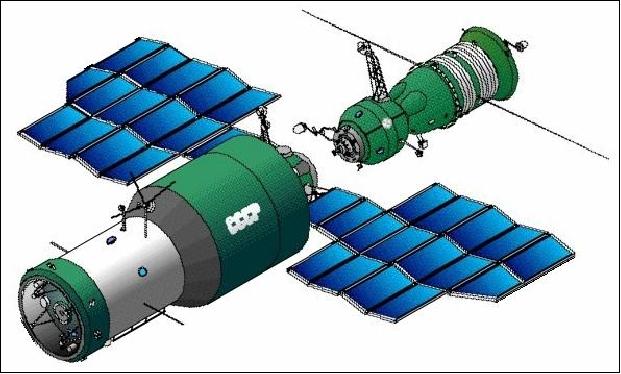
• The OPS-2, announced as Salyut-3, was launched on June 25, 1974 from Baikonur (international designation: 1974046A). The crew of the Soyuz-14 spacecraft spent 15 days onboard the station from July 4-19, 1974 (Chelomey was directed to use the Soyuz spaceships instead of TKS during flight testing of OPS). The second expedition launched toward OPS-2 in August 1974 (Aug. 26-28, 1974), but failed to reach the station. Salyut-3 was deorbited in January 1975.
The OPS-2 space station had a launch mass of 18,900 kg, a max diameter of 4.15 m, a length of 14.55 m (habitable volume of 90 m3), a payload mass of about 5,000 kg, and power of 3 kW. Two main engines provided a thrust for maneuverability. Some features of Salyut-3 were:
- The spacecraft consisted of an airlock chamber, a large-diameter work compartment, and a small diameter living compartment
- Airlock chamber had four openings. The drogue unit of the pin and cone docking system filled the aft opening. The forward opening led into the large-diameter work compartment.
- Two propulsion units were located on the aft end of the large-diameter compartment, on either side of the airlock chamber.
- The OPS-2 featured solar arrays which could track on the sun in most station attitudes.
- The large-diameter portion of the station's work compartment (4.15 m diameter) was dominated by the Agat-1 Earth-observation camera, which had a focal length of 6.4 m and an aperture of about 1 m. The film camera was used primarily for military reconnaissance purposes. A so-called KSI (Information Return Capsule) could return film from Agat-1 to the ground by a parachute system. KSI had a mass of about 360 kg and a diameter of about 85 cm.
- The small-diameter living compartment (2.9 m diameter) was separated from the work compartment by a bank of 12 tanks for storing gas, presumably oxygen for breathing.
• The OPS-3, announced after the launch as Salyut-5, entered orbit on June 22, 1976. It was visited by two crews in the summer of 1976 (July 7 to Aug. 24 on Soyuz 21) and in the winter of 1977 (Feb. 8-25, 1977 on Soyuz 24). Between the two successful expeditions, one crew (2nd, launch Oct. 14, 1976 on Soyuz 23) failed to reach the station and had to conduct an urgent landing, resulting in the first-ever splashdown of a Soviet spacecraft. The Salyut-5 space station reentered the atmosphere on Aug. 8, 1977.
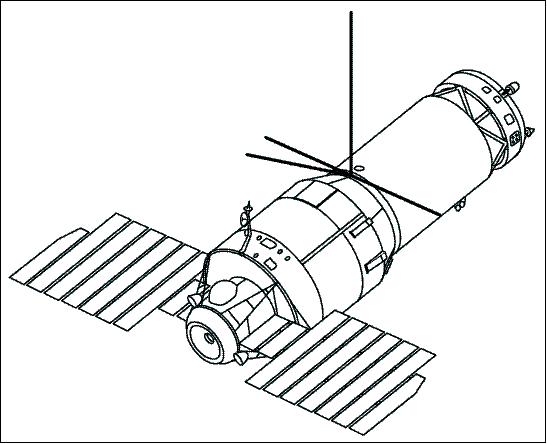
• The next Almaz station, OPS-4, promised a number of radical upgrades in the project. The objectives called for a side-looking radar system to be flown. The large folded antenna array for the radar system was mounted on the forward cylinder of the station. However, from the beginning of 1978, the funding for the manned Almaz project dwindled considerably, dragging the construction of OPS-4 behind schedule. The OPS-4 station was ultimately grounded and has become a rare artifact of the Almaz project.
• In June 1978, the Soviet government officially halted the development of manned orbital stations (OPS) at the TsKBM design bureau in Reutov (formerly OKB-52). As a consequence, the Almaz space station was downgraded to a heavy radar-carrying reconnaissance satellite, which could be visited by servicing crews and later to a fully unmanned (referred to as “automatic”) spacecraft. Three such satellites have been launched, two of which worked successfully in orbit.
• At the time of the cancellation of the manned Almaz program in Feb. 1979, design work had already begun on OPS-5 (designated ”Zvezda”), which would be equipped with docking ports for the TKS vehicles at both ends of the station.
The Unmanned Almaz Program
In 1983, TsKBM took its current name, NPO Machinostroyenia [(Machine Building Scientific Research and Production Enterprise), other spellings are: NPO Mashinostroyeniye, NPO Mashinostroyeniya, or simply: NPO Mash], and developed also the unmanned Almaz-T spacecraft series, a robotic variant of the Almaz manned orbital space station (the leftover Almaz space station hardware was converted into the unmanned Almaz-T series). Some of the unmanned Almaz-T spacecraft Earth observation program objectives were:
• Development of a series of automatic space stations on the basis of a universal Almaz platform
• Development of a sensor complement with upgrading capability in sensor performance characteristics with regard to spatial resolution, coverage, spectral characteristics, etc. Increase in the number of instruments and the number of solvable tasks with every mission.
• Development of a data system onboard and on-ground and a corresponding infrastructure to cope with the vast volumes of data.
• Provision of an all-weather remote sensing capability to support the following tasks:
- Prospecting for natural resources for many sectors of the national economy
- Collecting of remote sensing data for ecological analysis and applications
- Observing natural catastrophes/disasters of immediate interest.
The former USSR needed an all-weather remote sensing capability based on SAR technology, due to the cloud coverage conditions predominant in the northern latitudes of its land mass.
The first Almaz-T spacecraft was launched on Nov. 29, 1986 from Baikonur. However, due to a failure of the first and second stages of the Proton launcher (separation problems), the intended orbit was not reached resulting in a loss of the mission.
Cosmos-1870
This mission is regarded as the first USSR radar demonstration mission (second mission on the Almaz-T spacecraft). The satellite was launched on July 25, 1987 with a Proton-K vehicle from the Baikonur Cosmodrome launch facility. The mission was officially identified as Cosmos-1870. 5)
Spacecraft mass = 18550 kg, payload mass = 1950 kg, design life = 2 years, attitude precision = 15-20 arcmin, stabilization precision = 4-6 arcmin.
Orbit: mean altitude = 275 km, inclination = 73º, orbital period = 92 minutes
Sensor Complement
(Ekor-A, TV System)
Ekor-A (Sword), a side-looking SAR (Synthetic Aperture Radar) instrument in S-band with a center frequency of 3.125 GHz (wavelength of 9.6 cm, HH polarization). The instrument was built by the NPO Vega-M design bureau, Moscow. The observation data provided a spatial resolution of about 25-30 m on a swath of 20 km.
The S/C carried two Ekor instruments, one on each side for surveying. The S/C had the capability to roll about its axis, thereby extending the pointing range of the SAR antennas in the cross-track direction up to 250 km field of regard (swath width is nearly constant at 20 km). The S/C had three tons of fuel on board permitting many roll maneuvers for this type of operational support.
Data: onboard recording capability of its SAR data (video tape recorder) and subsequent stored data dump during passes over ground stations, or real-time data transmission. Data transmission rate: 90 Mbit/s.
Mission Status
The spacecraft operated successfully for 2 years. The Cosmos-1870 mission ended on July 30, 1989 when the spacecraft was deorbited.
Almaz-1 Mission
The Almaz-1 spacecraft was launched on March 31, 1991 on a Proton booster from the Baikonur Cosmodrome launch facility. The satellite has a total mass of 18,550 kg, and a payload mass of 3420 kg. Attitude precision = 15-20 arcmin, stabilization precision = 4-6 arcmin. The stabilization precision during the SAR operation is about 1 arcmin. Attached to the spacecraft bus were two solar panels (86 m2 in total size) capable of generating an average power of 2.4 kW, a peak power of 7.5-10 kW, and two 3-panel SAR antennas (1.5 m x 15 m) along either side of the spacecraft. 6) 7) 8) 9) 10) 11)
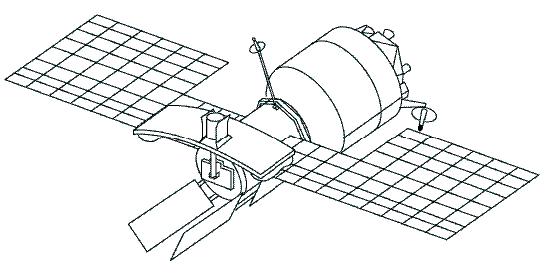
At the time, Almaz-1 was considered an important operational satellite (after SEASAT in 1978, SIR-A in 1981, SIR-B in 1984 and Cosmos-1870 in 1987) with a radar sensor for Earth observation. The Soviet entity Glavkosmos had contractual agreements (Western marketing rights for Almaz data) with Almaz Corporation, a subsidiary of the Houston-based Space Commerce Corp. (SCC). Scenes of 40 km x 40 km in size were available for purchase from the Almaz Corporation for $2500 per scene.
Application: oceanology (study of the distribution and dynamics of currents and hydrospheric fronts, the spatial structure of wave formations and turbulence, the evaluation of surface winds and hurricanes, the topography of the ocean floor and its effects on wave patterns at the surface, the identification of oil spills and other forms of pollution, the state of the ice cover and its seasonal variations, boundaries of water exchange of rivers with the ocean, etc. ); geology (structure of geological formations (such as folds, valleys and fractures) and the nature of volcanic activity, survey of mineral deposits, etc.); cartography and geophysics (topographical maps, climatic changes (such as ice thawing and desertification)); agriculture and forestry (large scale evaluation of agricultural lands and crops, overall volume of the biomass in a region, soil moisture conditions, etc.); statistics, ecology, etc.
Orbit: Non-sun-synchronous circular orbit, altitude = 270-380 km, inclination = 72.7º, orbital period = 92 minutes.
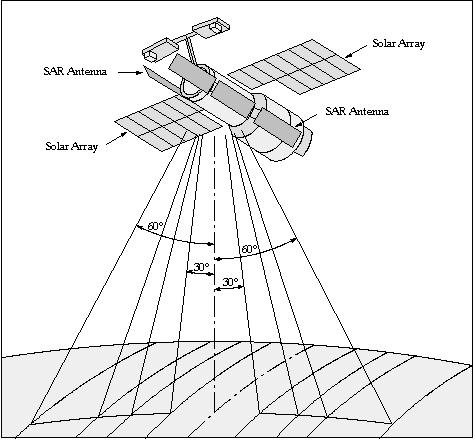
Mission Status
The operational phase of Almaz-1 started in May 1991. However, the rather low orbit selection of the spacecraft required many re-boosts due in particular to increased solar activity in the 1991/2 period resulting in increased atmospheric drag. End of mission: Oct. 17, 1992 after about 17 months of service (controlled descent into the Pacific ocean due to lack of fuel).
Sensor Complement
Ekor-A1 (Sword-A1)
Ekor-A1 is a side-looking SAR (Synthetic Aperture Radar) instrument in S-band with a center frequency of 3.125 GHz, wavelength = 9.6 cm, built by the NPO Vega-M design bureau of Moscow. The S/C carried 2 Ekor-A1 instruments, used to observe a swath on each side of the spacecraft (steerable within a FOR of 350 km). The Ekor-A1 complex represented an upgrade of the Ekor-A complex flown on Cosmos-1870. Also, the SAR complex onboard the Almaz-1 spacecraft featured a digital magnetic storage and data link through the satellite retransmitter.
- Resolution = 10-15 m (depending on range and azimuth)
- Polarization: HH
- SAR images can be taken from each side of the satellite; the swath width of each SAR is 40 km within a field of regard (FOR) of 350 km (obtained by rolling the spacecraft)
- Observation (incidence) angles: 30-60º
- Radiometric resolution: 2-3 dB
Note: After the launch, ground control discovered a failure of the communications antenna designed to downlink the imagery via the Luch relay satellite. In addition, one of the solar panels failed to deploy completely, leaving the main radar panel of the spacecraft partially blocked. In spite of these problems, the SAR instrument did manage to provide data.
Microwave Radiometer
The microwave radiometer is a multichannel instrument operating in the wavelength region of 0.8 - 5 cm, or in the frequency range of 37.5 - 6 GHz, respectively. Resolution of a pixel cell = 10-30 km on a swath of about 600 km; temperature resolution of 0.1 - 0.3 K. Objective: compilation of an Earth surface temperature map.
Data: Ground station in Moscow Region. The Almaz-1 schedule calls for a transmission of 60 images (=scenes per day). Nominal data rate of 90 Mbit/s. Operational modes: onboard data recording and subsequent transmission via relay satellite to a DRP (Data Reception Point).
Almaz-1B (Almaz-1V)
In the aftermath of Almaz-1 until about 1997, NPO Machinostroyenia was planning on a follow-on mission to Almaz-1, namely Almaz-1B, a civilian Earth resources satellite of the military version Almaz-1V, equipped with more advanced SAR instruments (2 Ekor-A, a 4-band optical imager, etc.) providing higher resolution data from an orbit of ~ 600 km (a life expectancy of 5 years for the mission). NPO Machinostroyenia had hoped to commercialize its Almaz technology, launching another spacecraft in the mid-1990s and marketing its imagery worldwide. 12)
Note: Almaz-1B is occasionally also referred to as Almaz-2.
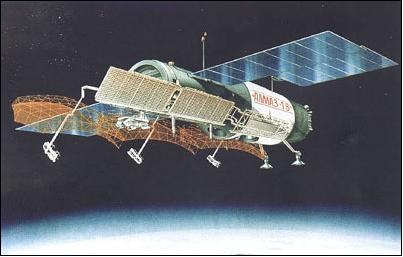
However, after the end of the Cold War, the funding for the project all but dried out within the Russian Federation. All attempts by the management at NPO Machinostroyenia to raise private funds for the program, and even an appeal to the International Monetary Fund (IMF), turned out to be fruitless. As a result, NPO Machinostroyenia had to abandon the Almaz program in the late 1990s.
Epilog: The Almaz and TKS designs, however, live on into the 21st century - the Almaz as the ISS (International Space Station) base block since the Zvezda module is of OPS-5/Almaz heritage.
• The Zarya or FGB (Functional Cargo Block) module of ISS is based on the TKS spacecraft, originally designed for the canceled project of the Almaz military orbital station in the 1970s (the TKS design was also part of the Mir space station modules). Zarya (sunrise) is serving as the first module of ISS (International Space Station) in orbit, launched Nov. 20, 1998 on a Proton vehicle from the Baikonur Cosmodrome in Kazakhstan. Zarya, a 20,040 kg pressurized module, provided electrical power, storage, propulsion, and guidance, to the ISS during the initial stage of assembly. Zarya acted also as an adapter between the US and Russian-built ISS segments. Zarya was built for NASA by KhSC (Khrunichev State Research and Production Space Center) of Moscow in cooperation with Russian space industry, under contract with the US Boeing Company. Construction of the Zarya module started in late 1994 at KsSC.
• The Russian-built Zvezda (meaning “star”) Service Module (SM) was launched on July 12, 2000 by a Proton-K vehicle from Baikonur (ISS 1R flight). Zvezda was docked to ISS on July 26, 2000. The Zvezda Service Module is Russia's main contribution to ISS. Zvezda took over the main Zarya functions when it was attached to the ISS; it provided a) the first primary living quarters for three-person crews, b) primary docking port for Progress-type cargo resupply vehicles, c) power and steering (propulsive attitude control and reboost) capability to keep ISS in a safe orbit.
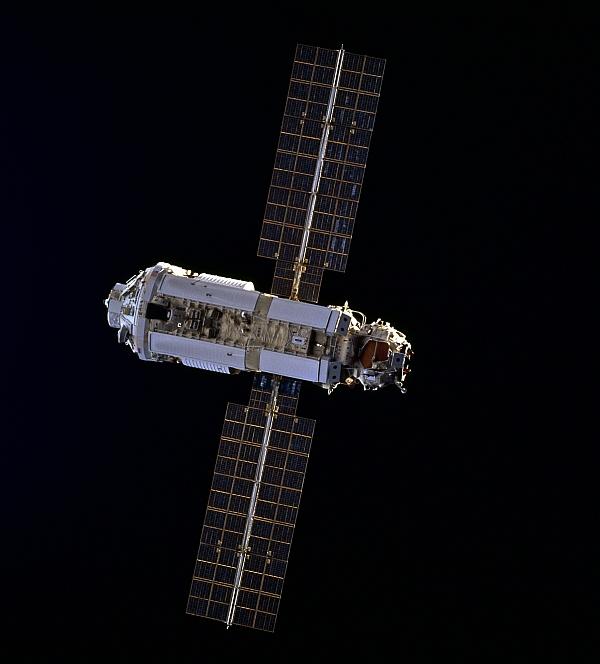
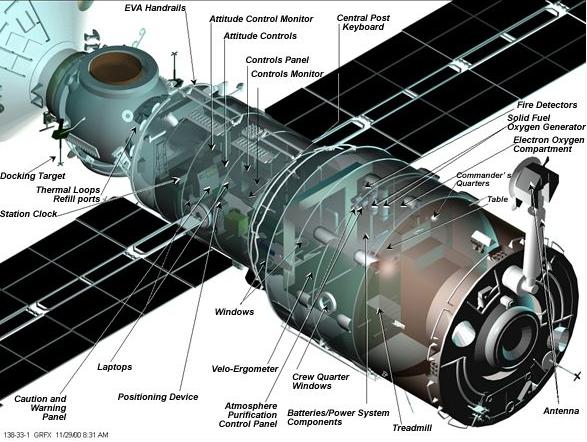
References
1) Anatoly Zak: http://www.russianspaceweb.com/spacecraft.html
2) “Part 2 Almaz/Salyut/Mir” of NASA,:URL: http://spaceflight.nasa.gov/history/shuttle-mir/references/documents/mirhh-part2.pdf
3) Sven Grahn, “The Almaz Space Station Program,” http://www.svengrahn.pp.se/histind/Almprog/almprog.htm
4) Mark Wade, http://www.friends-partners.org/partners/mwade/craft/almaz.htm
5) V. S. Verba, L. B. Neronskiy, I. G.Osipov, “Russian Spaceborne Imaging Radars: Scientific and Technical Achievments and Priority Perspectives of Development,” URL: http://www.ursi.org/Proceedings/ProcGA05/pdf/F08.2(0598).pdf
6) “Soviets Launch Largest Earth Resources Satellite on Modified Salyut Platform,” Aviation Week & Space Technology/April 8, 1991, pp. 21-22
7) “Almaz to add Dimension to Earth Study,” Space News, March 18-24, 1991, p. 1
8) “ALMAS - Sowjetischer Erdsatellit mit Synthetic Aperture Radar zur Erderkundung,” IKF Berlin, 1990 , aus der Reihe: Informationen aus der internationalen Zusammenarbeit
9) “Sowjetisches Weltraumauge sammelt Ströme digitaler Daten,” VDI Nachrichten, 21. Dez., 1990, Seite 20
10) “Almaz Falls from Orbit,” Space News, Oct 26-Nov. 1, 1992, p. 1
11) http://www.astronautix.com/craft/almazt.htm
12) M. Wade, “Almaz-1B,” URL: http://www.astronautix.com/craft/almaz1b.htm
13) http://en.wikipedia.org/wiki/Zvezda_%28ISS%29
The information compiled and edited in this article was provided by Herbert J. Kramer from his documentation of: ”Observation of the Earth and Its Environment: Survey of Missions and Sensors” (Springer Verlag) as well as many other sources after the publication of the 4th edition in 2002. - Comments and corrections to this article are always welcome for further updates (eoportal@symbios.space).